Judith Works's Blog, page 12
March 18, 2012
The Samurai Legacy of Chiran
We were enveloped in a soft silky rain as if we were in a Japanese watercolor. The moisture lent a dull sheen to the blue tile roofs and the stone lanterns along the roadside leading to the Peace Museum.
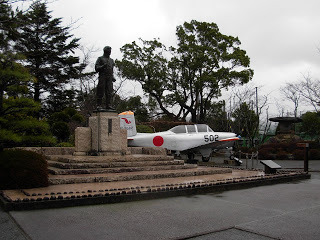
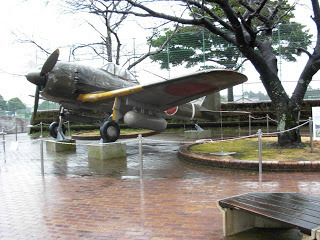 We were out for a day in Chiran, about an hour away from Kagoshima a city located on a narrow bay of the same name on Japan's southernmost major island, Kyushu. The countryside with small towns and farms was peaceful but our first stop, the interestingly named Peace Museum, was a shock. It was dedicated to peace in the form of a lesson about the period during World War II when the Japanese kamikaze planes relentlessly attacked American ships near Okinawa in a futile effort to stop the US advance into the Japanese Homeland.
We were out for a day in Chiran, about an hour away from Kagoshima a city located on a narrow bay of the same name on Japan's southernmost major island, Kyushu. The countryside with small towns and farms was peaceful but our first stop, the interestingly named Peace Museum, was a shock. It was dedicated to peace in the form of a lesson about the period during World War II when the Japanese kamikaze planes relentlessly attacked American ships near Okinawa in a futile effort to stop the US advance into the Japanese Homeland.
The entrance path led us past restored war planes and a large bronze bell to be rung when making prayers for peace.
The museum was crowded with Japanese of all ages. We, a small group of Americans, were hosted by a historian who gave a background lecture and then led us around the display cases while describing the uniforms and the faded letters the pilots wrote to their mothers and sweethearts before they climbed into the cockpits of planes so small that they could only carry a bomb under one wing and a fuel tank under the other. The walls were lined with photos of these handsome young men who flew the planes knowing full well that they would never come home because even if they weren't shot down they only had enough fuel for a one-way trip. Echoing through the hall was the sound of battle: a video showing an endless loop of planes diving into US ships, horrific explosions, and the planes that didn't crash into ships in nose dives as they plumetted into the sea. A restored Mitsubishi Zero, dredged out of the sea, occupied a separate room. Rather than peace it seemed that desperation was the most descriptive word to describe the museum. What did the Japanese who filled the halls think? We couldn't find out but wondered if the elderly wished they had won and if the younger generation cared at all.
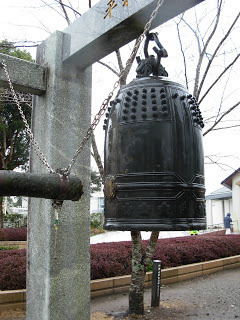
As we departed we rang the bell in the faint hope for world peace. Our narrator told us that the stone lanterns we had admired on the drive were commemorations – one for each of the 1036 pilots from the nearby airfield who died.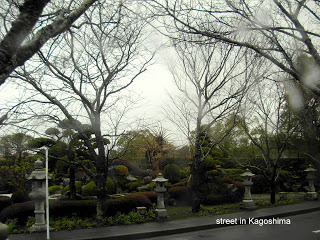
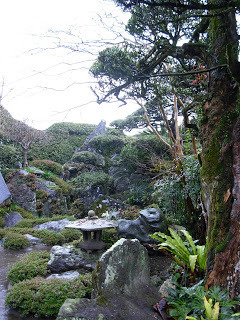
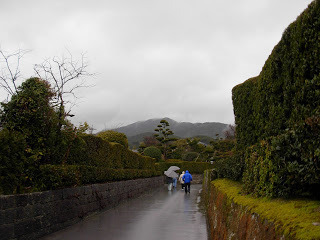
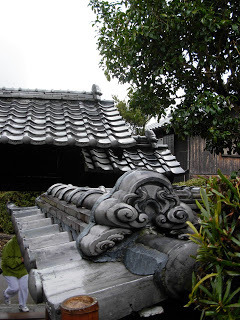
Nearby was a lane with seven samurai homes and gardens – the view of Japan that enchants rather than provokes thoughts of the more recent past. The samurai, too, were warriors – upper class swords for hire who lived and fought for their feudal lords. But they had a timeless artistic vision expressing serenity. The tile-roofed houses, all about 250 years old, are set back from a lane and surrounded by clipped hedges and trees. Rock gardens invite contemplation. Some of the hedges are made of camellia bushes, pink flowers peeking through the foliage. Other visitors with their umbrellas strolled toward the last house where a small tea room awaited us. The hostesses in kimonos poured the bitter fragrant beverage into tiny porcelain cups. We rested on a stone bench outside the walls of shoji screens to look over the tiles and up the lane thinking of a Japan long ago and how bitter enemies can become friends.
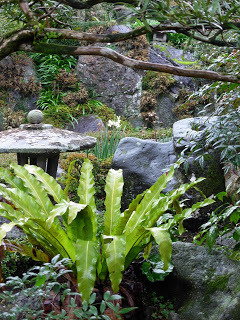
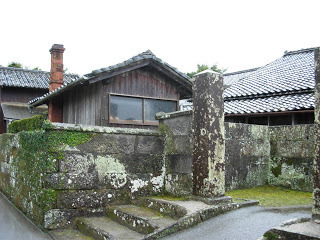


 We were out for a day in Chiran, about an hour away from Kagoshima a city located on a narrow bay of the same name on Japan's southernmost major island, Kyushu. The countryside with small towns and farms was peaceful but our first stop, the interestingly named Peace Museum, was a shock. It was dedicated to peace in the form of a lesson about the period during World War II when the Japanese kamikaze planes relentlessly attacked American ships near Okinawa in a futile effort to stop the US advance into the Japanese Homeland.
We were out for a day in Chiran, about an hour away from Kagoshima a city located on a narrow bay of the same name on Japan's southernmost major island, Kyushu. The countryside with small towns and farms was peaceful but our first stop, the interestingly named Peace Museum, was a shock. It was dedicated to peace in the form of a lesson about the period during World War II when the Japanese kamikaze planes relentlessly attacked American ships near Okinawa in a futile effort to stop the US advance into the Japanese Homeland. The entrance path led us past restored war planes and a large bronze bell to be rung when making prayers for peace.
The museum was crowded with Japanese of all ages. We, a small group of Americans, were hosted by a historian who gave a background lecture and then led us around the display cases while describing the uniforms and the faded letters the pilots wrote to their mothers and sweethearts before they climbed into the cockpits of planes so small that they could only carry a bomb under one wing and a fuel tank under the other. The walls were lined with photos of these handsome young men who flew the planes knowing full well that they would never come home because even if they weren't shot down they only had enough fuel for a one-way trip. Echoing through the hall was the sound of battle: a video showing an endless loop of planes diving into US ships, horrific explosions, and the planes that didn't crash into ships in nose dives as they plumetted into the sea. A restored Mitsubishi Zero, dredged out of the sea, occupied a separate room. Rather than peace it seemed that desperation was the most descriptive word to describe the museum. What did the Japanese who filled the halls think? We couldn't find out but wondered if the elderly wished they had won and if the younger generation cared at all.

As we departed we rang the bell in the faint hope for world peace. Our narrator told us that the stone lanterns we had admired on the drive were commemorations – one for each of the 1036 pilots from the nearby airfield who died.




Nearby was a lane with seven samurai homes and gardens – the view of Japan that enchants rather than provokes thoughts of the more recent past. The samurai, too, were warriors – upper class swords for hire who lived and fought for their feudal lords. But they had a timeless artistic vision expressing serenity. The tile-roofed houses, all about 250 years old, are set back from a lane and surrounded by clipped hedges and trees. Rock gardens invite contemplation. Some of the hedges are made of camellia bushes, pink flowers peeking through the foliage. Other visitors with their umbrellas strolled toward the last house where a small tea room awaited us. The hostesses in kimonos poured the bitter fragrant beverage into tiny porcelain cups. We rested on a stone bench outside the walls of shoji screens to look over the tiles and up the lane thinking of a Japan long ago and how bitter enemies can become friends.


Published on March 18, 2012 11:02
March 11, 2012
Dinner with the Captain
I should say captains; for reasons I cannot fathom my husband and I have ended up at the captain's table more times than is warranted. Especially since we always have a cabin much closer to the oilers and wipers than to the Lido Deck.
There must be some reason: perhaps there is a lottery or perhaps there is a need to keep an even keel by making a selection from both the upper and lower classes since even steerage passengers have the run of the ship in these modern times. Whatever – the dinners have often proved to be far more entertaining than the host intended.
The most spectacular event came off the coast of Albania. We were eleven seafarers. Our captain made twelve. Somehow one couple, a doctor and his society wife, breached protocol by seating themselves to the captain's right before the rest of us entered the main dining room ceremoniously so that all the other guests could sigh with envy. Led in by the ship's "hostess," we, the remaining nine, traipsed in: two normal-looking well groomed Scottish ladies, an American psychiatrist with large round spots of rouge on her cheeks and red hair worn Angela Davis style along with a nondescript husband. They were followed by a grandmother, broomstick thin, her daughter with plenty of ballast and a plump two-year old grandchild. Hubby and I brought up the rear. Presaging trouble, the table was only set for eleven, resulting in a scramble to find an extra chair and squeeze us all in. When I found my misspelled place card I saw that I was cozied up with the captain on his left.
As soon as the wine was poured the stick thin woman jumped up to make the toast. "What happens at the captain's table stays at the captain's table, just like Vegas" she announced. The captain, who was just starting to open his mouth to propose his own toast, sat down, silenced by the outburst while we all wondered just what would happen "like in Vegas." Hi-stakes gambling, ladies of the night cavorting on the table or ????
It didn't take long to find out. The answer was we were to be the recipients of fascinating stories from the woman's life. She proceeded to tell us in depth and non-stop about the fascinating grocery business she owned, the enormous price of her waterfront condo and its fees and all the sports stars she knew. She then shouted across the table to address the doctor, who was from the same area. Where were his seats in the pro-football stadium? He reluctantly admitted that his were only on the 40 yard line although he assured us that he knew a lot of sports stars too. Thin woman crowed that her season's tickets were on the 50.
Meanwhile the waiter was told that the child would only eat ice cream. The poor tot had her nose resting on her i-pad screen while the mother regaled us with stories about taking the little girl to New York to see her favorite play, How to Succeed in Business Without Trying. A precocious entrepreneur it seemed.
The captain tried to steer the conversation elsewhere by asking the two Scottish ladies about their experiences but it was too late – thin woman had already launched into an interminable story about all her Prada handbags, alligator and ostrich being favored, and her private tours to outlet malls. The tired child started to whine. Then the doctor suddenly announced that he and the other two male guests had to change places like musical chairs. After they settled the psychiatrist's husband, who had been silent throughout the meal, looked at the whining child and said, "Jonathan Swift said that children should be boiled until tender before being eaten."
Well, at least this captain didn't try to feel me up like on another cruise.
Published on March 11, 2012 07:53
February 20, 2012
Oracles & Sibyls
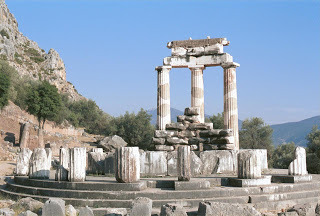 Oracles & sibyls, those fascinating forecasters, were popular with the ancient Greeks and Romans who flocked to shrines to learn their fates. I'm never quite clear on the difference but my classical dictionary says that an oracle transmits the response of a god to a question asked by a worshipper. A sibyl was a female prophet, apparently not needing a god to get involved in the process.
Oracles & sibyls, those fascinating forecasters, were popular with the ancient Greeks and Romans who flocked to shrines to learn their fates. I'm never quite clear on the difference but my classical dictionary says that an oracle transmits the response of a god to a question asked by a worshipper. A sibyl was a female prophet, apparently not needing a god to get involved in the process. One of the most memorable days I ever spent immersed in the ancient world was a visit to Delphi, dedicated to Apollo and home of the Delphic Oracle, called Pythia, by tradition a local woman over age 50. The area was a center of worship before the first millennium BC and was still in operation in 385 AD when Emperor Theodosius abolished it. The site, not far from Athens, retains an aura of mystery because of the beauty of its surroundings and the evocative ruins of temples in the Sacred Precinct. This most famous shrine to Apollo in the ancient world rests on Mount Parnassus' steep slopes. The location was considered to be the center of the earth and was therefore sacred to the god as well as home to the muses, personifications of poetry, music and learning.
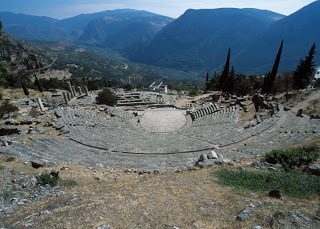
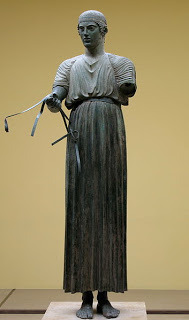 After wandering around the ruins filled with temples, a theatre, gymnasium, and a museum where the exquisite bronze statue of a charioteer stares solemnly into the distance with his glass eyes, I sat among the ruins in warm, hazy air gazing on endless silver-green olive groves punctuated with whorled cypress trees sloping down the hills. The age of Apollo seemed to return and it was easy to visualize the streams of worshippers bringing gifts, watching plays and athletic competitions. But perhaps I was only breathing the faint fumes still wafting in the breeze from a chasm where the oracle sat on a tripod speaking in Apollo's name. It is said that she chewed on laurel leaves and breathed the fumes from the rotting corpse of a giant snake, the Python, for inspiration. More prosaically the fumes are thought to be ethylene which can produce out of body experiences. Her trance enabled her to respond to questions from devotees with religious, moral and political problems. But she didn't answer any of mine.
After wandering around the ruins filled with temples, a theatre, gymnasium, and a museum where the exquisite bronze statue of a charioteer stares solemnly into the distance with his glass eyes, I sat among the ruins in warm, hazy air gazing on endless silver-green olive groves punctuated with whorled cypress trees sloping down the hills. The age of Apollo seemed to return and it was easy to visualize the streams of worshippers bringing gifts, watching plays and athletic competitions. But perhaps I was only breathing the faint fumes still wafting in the breeze from a chasm where the oracle sat on a tripod speaking in Apollo's name. It is said that she chewed on laurel leaves and breathed the fumes from the rotting corpse of a giant snake, the Python, for inspiration. More prosaically the fumes are thought to be ethylene which can produce out of body experiences. Her trance enabled her to respond to questions from devotees with religious, moral and political problems. But she didn't answer any of mine.* * *
Cumae, an ancient temple complex similar to Delphi but only a couple of hours south of Rome, was established by the Greeks in the 8th Century BC. Not much remains except the cave where the Cumaen Sibyl spun out her prophecies. She must have been a fearful sight if we can believe Michelangelo. Of the five sibyls depicted in the Sistine Chapel, she's the ugly one, rendered with aged and masculine features and upper body and arms like those of a weightlifter. The sibyl was reputed to have shunned sex – thus Michelangelo painted her legs and feet primly poised together as she intently studies her book. Her fame rests on offering nine books of prophecies to an Etruscan king of Rome in the sixth century BC. He declined to buy them because of the cost. She burned three and offered the remainder to the king at the same price. He refused again whereupon she burnt three more. He gave in and purchased the last three at full original price. They were kept in the Temple of Jupiter on the Capitoline Hill in Rome to be consulted in emergencies, not that in the end they did any good.
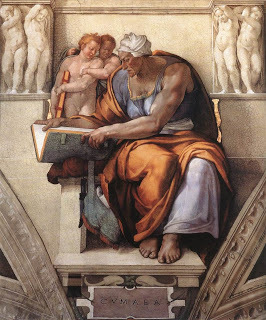
When she was "alive" she sat at the end of a 145 foot long trapezoidal tunnel cut through solid rock. The tunnel and the surrounding remains are located not far from the volcanic and sulfurous Phlegrean Fields and Lake Avernus, considered to be an entrance to Hades.
Virgil described the sybil's fearsome power: "Through the amplification of her hollow vaults, the sibyl cast her warnings, riddles confused with truth." Despite her powers she came to a peculiar end. She asked Apollo to let her live as long as the number of grains of sand she held in her hand. Apollo granted her wish but because she forgot to ask for enduring youth she slowly withered away, ending up in a small jar. In the end only her voice was left, and that, too, is long gone thus preventing me from asking her any questions.
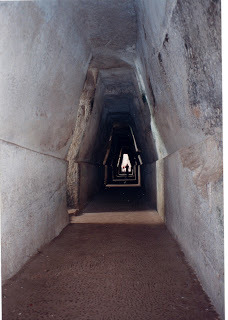
The tunnel had a few openings for light cut into the cliff facing the sea. My husband and I stumbled along in the dimness. By the time we reached her cave at the end it was easy to think of the ancients quivering while awaiting some word on the future as she wrote their destiny in riddles confused with truth. The mood was unsettling and we didn't linger, anxious to return to the emotionally cleansing sunlight.
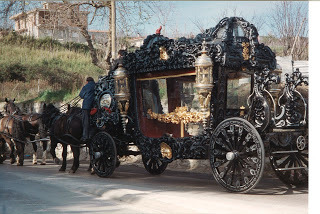
When we emerged into the brilliance after one visit we were suddenly transported to a relic of the 18th
Published on February 20, 2012 15:13
February 15, 2012
Good food & Wine and Not Much Exercise
 On our first trip to Oregon's Willamette Valley wine country some years ago we floated in a balloon high above the vineyards early on a sunny summer morning. This time around we were greeted by a watery winter sun when we arrived in Newberg for wine tasting with friends. In the morning we drove through the peaceful countryside with its rolling hills covered with sleeping vines and filbert orchards where each tree was hung with hundreds of chartreuse colored catkins, presaging spring. In between the orchards and vineyards the rural scene was embellished with alpacas and llamas grazing alongside sheep and goats in green pastures.
On our first trip to Oregon's Willamette Valley wine country some years ago we floated in a balloon high above the vineyards early on a sunny summer morning. This time around we were greeted by a watery winter sun when we arrived in Newberg for wine tasting with friends. In the morning we drove through the peaceful countryside with its rolling hills covered with sleeping vines and filbert orchards where each tree was hung with hundreds of chartreuse colored catkins, presaging spring. In between the orchards and vineyards the rural scene was embellished with alpacas and llamas grazing alongside sheep and goats in green pastures. 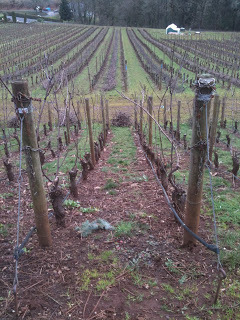
Our drive was just a short tour covering parts of three North Willamette Valley American Viticultural Areas: Chehalem Mountains, Ribbon Ridge and Dundee Hills, all famous for prize-winning Pinot Noirs. The Worden Hill Wine Trail in the Ribbon Ridge area was having an open house at all ten wineries – far too many to visit, especially before lunch. But we did stop at the venerable Aldesheim tasting room and at Black Walnut which has a gorgeous hilltop inn with expansive views over their vineyards and the misty Valley. The proprietor was busy getting a shipment of their Pinot Noirs to Germany ready to go. The luxurious inn would look at home in Tuscany – truly a place to celebrate a special event.
Lunch was at Recipe, an old home turned into a stylish bistro filled with voluble eaters and drinkers. Glenn had Croque Madame, rich with ham and Gruyere topped with an egg sunny side up. I tried the vinaigrette-dressed warm bitter greens dotted with thick-cut bacon pieces and chestnuts all topped with a slice of country bread also supporting a just-laid egg. Of course, a glass of Pinot Noir from their extensive wine list accompanied our meal.
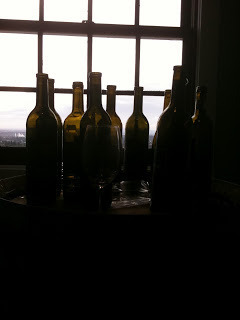
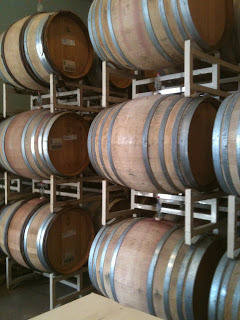
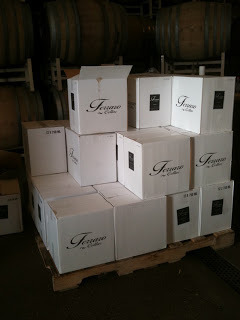 Soon it was time for our first official tasting. We started at Ferraro Cellars, owned by another friend, one who had visited us in Italy. In contrast to many of the other wineries in the area he concentrates on Merlot, Cabernet Sauvignon and Zinfandel made from grapes grown east of the Cascade mountains. A few sips encouraged us to buy a case of his Merlot to put aside in our own small cellar. The next stop was at Archery Summit, home to highly rated Pinot Noirs. Our tasting event was presented formally in their candle-lit cave filled with rows of huge oak barrels full of aging wines. Soon bottles of 2009 Premier Cuvee joined the others already in the car trunk.
Soon it was time for our first official tasting. We started at Ferraro Cellars, owned by another friend, one who had visited us in Italy. In contrast to many of the other wineries in the area he concentrates on Merlot, Cabernet Sauvignon and Zinfandel made from grapes grown east of the Cascade mountains. A few sips encouraged us to buy a case of his Merlot to put aside in our own small cellar. The next stop was at Archery Summit, home to highly rated Pinot Noirs. Our tasting event was presented formally in their candle-lit cave filled with rows of huge oak barrels full of aging wines. Soon bottles of 2009 Premier Cuvee joined the others already in the car trunk.Replete with enough tasting for the day we moved on to dinner in a delightful restaurant called SubTerra (because it is down a flight of steps between two tasting rooms). We lingered long over wild mushroom risotto and skillet roasted mussels in marinara sauce. Like much of the food served in the area the mussels were locally sourced, in this case fresh from Netarts Bay on the Oregon Coast. Our selections were listed as "small plates" but were almost more than we could eat. With bottles lined up along a ledge next to our table we were tempted into having just one more glass to make our day complete.
Winter is peaceful but our next trip will be at harvest time when the color of the vines and their fruit will brighten the scene.
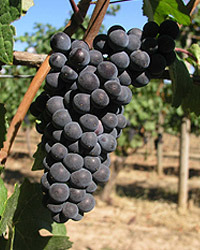 Courtesy Wikipedia
Courtesy Wikipedia
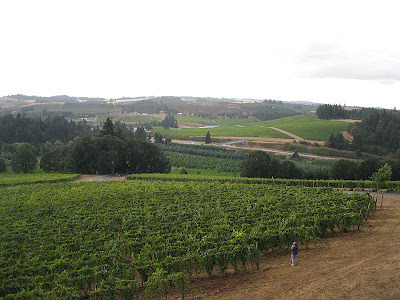 Courtesy Wikipedia
Courtesy Wikipedia
Published on February 15, 2012 10:18
February 8, 2012
How Do I Pick a Hotel?
Margo and Briana from The Travel Belles have asked how their readers pick a hotel. The question is for this week's edition of Across the Cafe Table. My answer required some thought when I realize that I have stayed in about every type of hotel found in a zillion sorts of ways. A few highlights and lowlights come rapidly to mind:
The "B&B" in Bodrum reserved for us by a "friend." Slavering Doberman tied up by the door and toilet in the yard. But another in Isparta, central Turkey, found by asking the locals who led us to the new hotel Brifing where we listened to a Stravinsky concert and watched the resident generals drive up in their flagged staff cars for a Rotary Club meeting.
The Serena in Zanzibar where we stayed with friends who had heard about it and the resort of Ras Kutani also recommended by old Africa hands.
The evocative Taybat Zeman in Petra, recommended by an Egyptian co-worker.
The lovely Villa Margarita on the Brenta Canal found in the French guide, Hotels de Charme.
The ghastly half-ruined castle in southern Italy where there was no heat in winter and the wind was so strong it blew the toilet roll in a stream of flapping paper out the broken bathroom window. That was in an English guide to Italian hotels. (Ditched the book)
The splendid Norfolk in Nairobi and the tiny hotel near Ankor Wat where for $15 a night you got CNN and the need for flea powder. Both courtesy of the UN.
Another UN pick: the beautiful and doomed Hotel Montana in Port-au-Prince not long before it collapsed in the earthquake killing all within.
The delightful La Suite Villa on Martinique. I ran across it while searching sites about the island then checked it out on Trip Advisor. When I found the French loved it that sealed the deal.
The Best Western Hotel Amazonia in Cayenne, Guyana found by my travel agent when we were in extremis.
And the nicest of all: Le Hameau in St. Paul de Vence, recommended by a friend.
So...there is no best way. Take a chance and see what happens!
The "B&B" in Bodrum reserved for us by a "friend." Slavering Doberman tied up by the door and toilet in the yard. But another in Isparta, central Turkey, found by asking the locals who led us to the new hotel Brifing where we listened to a Stravinsky concert and watched the resident generals drive up in their flagged staff cars for a Rotary Club meeting.
The Serena in Zanzibar where we stayed with friends who had heard about it and the resort of Ras Kutani also recommended by old Africa hands.
The evocative Taybat Zeman in Petra, recommended by an Egyptian co-worker.
The lovely Villa Margarita on the Brenta Canal found in the French guide, Hotels de Charme.
The ghastly half-ruined castle in southern Italy where there was no heat in winter and the wind was so strong it blew the toilet roll in a stream of flapping paper out the broken bathroom window. That was in an English guide to Italian hotels. (Ditched the book)
The splendid Norfolk in Nairobi and the tiny hotel near Ankor Wat where for $15 a night you got CNN and the need for flea powder. Both courtesy of the UN.
Another UN pick: the beautiful and doomed Hotel Montana in Port-au-Prince not long before it collapsed in the earthquake killing all within.
The delightful La Suite Villa on Martinique. I ran across it while searching sites about the island then checked it out on Trip Advisor. When I found the French loved it that sealed the deal.
The Best Western Hotel Amazonia in Cayenne, Guyana found by my travel agent when we were in extremis.
And the nicest of all: Le Hameau in St. Paul de Vence, recommended by a friend.
So...there is no best way. Take a chance and see what happens!
Published on February 08, 2012 11:00
February 6, 2012
Shoe Shopping
There is something atavistic about shopping in the open air markets in Rome. We often browsed in the stalls, so much more appealing than looking at goods neatly arranged in cavernous supermarkets with their deadening fluorescent lights and dearth of human interaction. Wandering past merchants calling me to look at their cheese, fruit, vegetables, shoes, sweaters and piles of useless trinkets for our apartment took me mentally back into history, to the way everyone had always met their daily needs for food and other necessities. On Saturdays we sometimes went to the block-square Testaccio market with a stop at the divine food emporium, Volpetti, on the way. Both were located near a derelict former slaughterhouse, complete with a statue of a bull meeting his end looming over the main gate. The neighborhood is named for Monte Testaccio, a 100 foot-high hill made of broken amphorae that originally contained oil, wheat and other commodities imported to ancient Rome. The newest additions to the pile were dated to AD 140.
Volpetti was (and is) the best deli in Rome but the prices were astronomical. We tried not to drool on the displays of cheese, pasta, olive oil, balsamic vinegar, preserves, pâtés, whole prosciutti and sausages. These temptations were displayed in the windows, in glass-fronted cases, hung from the ceiling, piled on shelves and on stands in such profusion that it was hard to move among the cornucopia, the customers and the staff passing out samples. We always found room for a few samples and an etto or two of some cheese or prosciutto to take home for lunch on the terrace.
More to our budget, the Testaccio market a little farther on had reasonable prices and a prodigious selection of beautiful fruits and vegetables along with seafood and meat. In summer the fish smell permeated the atmosphere. It was wise to go early in the morning before the heat and odor got too intense. Best of all the goods, however, were the shoe stalls along one side. Fish smells or not, they were a goldmine because they sold the previous year's styles or overruns for bargain prices. I had difficulty worming my way to the front of the surrounding crowds despite using Glenn's technique of clinging to someone ahead.
I thought that shoes were a peculiar inclusion in a food market until I recognized that they were a staple as important as pasta and vegetables since the dawn of Italian history. One memorable fresco in the museum at Paestum depicts Venus wearing a pearl necklace, red shoes and nothing else. It was probably painted around the fifth century BC but it was easy to visualize a more modern Roman mistress in the same attire. Studying the variety of sandals on Roman statues could take a lifetime. Romans could buy shoes during the War when Italian troops were fighting in frozen snow without boots in Albania and Greece or at Monte Cassino. Even the pope is concerned with shoe styles, favoring red ones like ancient emperors.
Following long-standing tradition of being shoe-proud, I often left Testaccio market with a pair or two of shoes along with zucchini. But like looking over the vegetables before buying, I learned that is best to curb one's enthusiasm after my one shoe incidente. I found a splendid pair of bright blue leather and black patent stilettos and snapped them up after trying on the right one. I paid while the vendor placed the mate in the box and handed it over. When we returned home I tried them on only to find that one had a black sole and square toe and the other a light-colored sole and round toe. Maybe someone scrounged them from the garbage can after they landed there that afternoon. Caveat emptor as the ancient Romans said.Excerpt from Coins in the Fountain, a memoir of Rome.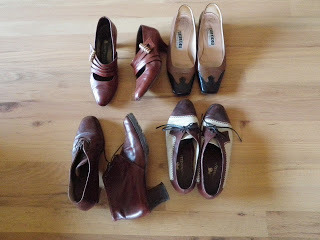

Volpetti was (and is) the best deli in Rome but the prices were astronomical. We tried not to drool on the displays of cheese, pasta, olive oil, balsamic vinegar, preserves, pâtés, whole prosciutti and sausages. These temptations were displayed in the windows, in glass-fronted cases, hung from the ceiling, piled on shelves and on stands in such profusion that it was hard to move among the cornucopia, the customers and the staff passing out samples. We always found room for a few samples and an etto or two of some cheese or prosciutto to take home for lunch on the terrace.
More to our budget, the Testaccio market a little farther on had reasonable prices and a prodigious selection of beautiful fruits and vegetables along with seafood and meat. In summer the fish smell permeated the atmosphere. It was wise to go early in the morning before the heat and odor got too intense. Best of all the goods, however, were the shoe stalls along one side. Fish smells or not, they were a goldmine because they sold the previous year's styles or overruns for bargain prices. I had difficulty worming my way to the front of the surrounding crowds despite using Glenn's technique of clinging to someone ahead.
I thought that shoes were a peculiar inclusion in a food market until I recognized that they were a staple as important as pasta and vegetables since the dawn of Italian history. One memorable fresco in the museum at Paestum depicts Venus wearing a pearl necklace, red shoes and nothing else. It was probably painted around the fifth century BC but it was easy to visualize a more modern Roman mistress in the same attire. Studying the variety of sandals on Roman statues could take a lifetime. Romans could buy shoes during the War when Italian troops were fighting in frozen snow without boots in Albania and Greece or at Monte Cassino. Even the pope is concerned with shoe styles, favoring red ones like ancient emperors.
Following long-standing tradition of being shoe-proud, I often left Testaccio market with a pair or two of shoes along with zucchini. But like looking over the vegetables before buying, I learned that is best to curb one's enthusiasm after my one shoe incidente. I found a splendid pair of bright blue leather and black patent stilettos and snapped them up after trying on the right one. I paid while the vendor placed the mate in the box and handed it over. When we returned home I tried them on only to find that one had a black sole and square toe and the other a light-colored sole and round toe. Maybe someone scrounged them from the garbage can after they landed there that afternoon. Caveat emptor as the ancient Romans said.Excerpt from Coins in the Fountain, a memoir of Rome.

Published on February 06, 2012 13:11
January 30, 2012
My First Cruise
It was a long time ago but the details remain fresh in my mind. I was on the loose and feeling a little sorry for myself. Then I saw a flyer posted in a travel agent's office window in the small town where I was living. The flyer looked somewhat homemade, not slick like the usual ones picturing luxury grand salons with impressive staircases and elegantly dressed couples sipping champagne. On the other hand the price was right and it wasn't going to be too much of an effort to get to San Diego where the one week voyage to Mazatlan, Puerto Vallarta, and La Paz was to set sail.
What did I know about cruising? Absolutely nothing other than it seemed a pleasant way to get some sun and a change of scene. Packing my new bikini and my 9-year old daughter off to the airport we headed for San Diego and down to the pier where the Good Ship Lollipop (otherwise known as the Orpheus) was awaiting us.
Orpheus was the Greek god who was able to charm the trees and animals when he played his lyre. But the ship should have been named Dionysus after the god of wine because it soon became apparent that a large proportion of the passengers were AA dropouts. They drank and they drank and then they drank even more. I watched them fall off the bar stools, stagger dangerously near the swimming pool and fight on the dance floor. After shore excursions they had to be dragged into the tender and then heaved into the cargo bay by the crew because they were unable to navigate the gangplank.
My daughter was goggle-eyed watching the unintentional lesson in "adult" behavior while she feasted on lobster and Baked Alaska, treats she wasn't likely to see again any time soon. Meanwhile, I received frequent invitations to attend a "real Greek party" after hours, and our handsome cabin attendant regularly stopped by to ask if I "needed something extra." The lure of my supposed attractions continued when I sensed that someone was following me on the beach in Puerto Vallarta. I turned around to see a tiny man with big muscles and a lot of chest hair. In broken English he explained that he would like to marry me and take me home to his mother in Greece. We had an extended conversation but in the end I declined that offer too and he returned to the engine room alone.
It wasn't just the passengers and crew that provided excitement. The ship ran into a tremendous storm while crossing the Sea of Cortez. Lines were rigged for the green-tinged passengers to grip hand over hand in the passageways. Most of the seasick crew retreated to their cabins. When the storm began to abate I found a deck chair where I could see the horizon through the flying spume. I was soon encrusted with salt from the spray, thus looking like Lot's wife. But instead of looking back at Sodom I watched our approach to the tiny port of La Paz. We anchored next to a ship that was winching cattle from the shore into the hold for their own cruise back across the Sea. The unhappy animals bellowed strenuously as they swung in the air suspended from ropes tied to their horns and mid-sections. They reminded me of my fellow passengers coming aboard after a too-happy day shoreside.
The Orpheus eventually left the Epirotiki Lines for a more sober life with Swan Hellenic cruises but it was sent to the breakers in 2000. On the other hand, I'm still cruising.

What did I know about cruising? Absolutely nothing other than it seemed a pleasant way to get some sun and a change of scene. Packing my new bikini and my 9-year old daughter off to the airport we headed for San Diego and down to the pier where the Good Ship Lollipop (otherwise known as the Orpheus) was awaiting us.
Orpheus was the Greek god who was able to charm the trees and animals when he played his lyre. But the ship should have been named Dionysus after the god of wine because it soon became apparent that a large proportion of the passengers were AA dropouts. They drank and they drank and then they drank even more. I watched them fall off the bar stools, stagger dangerously near the swimming pool and fight on the dance floor. After shore excursions they had to be dragged into the tender and then heaved into the cargo bay by the crew because they were unable to navigate the gangplank.
My daughter was goggle-eyed watching the unintentional lesson in "adult" behavior while she feasted on lobster and Baked Alaska, treats she wasn't likely to see again any time soon. Meanwhile, I received frequent invitations to attend a "real Greek party" after hours, and our handsome cabin attendant regularly stopped by to ask if I "needed something extra." The lure of my supposed attractions continued when I sensed that someone was following me on the beach in Puerto Vallarta. I turned around to see a tiny man with big muscles and a lot of chest hair. In broken English he explained that he would like to marry me and take me home to his mother in Greece. We had an extended conversation but in the end I declined that offer too and he returned to the engine room alone.
It wasn't just the passengers and crew that provided excitement. The ship ran into a tremendous storm while crossing the Sea of Cortez. Lines were rigged for the green-tinged passengers to grip hand over hand in the passageways. Most of the seasick crew retreated to their cabins. When the storm began to abate I found a deck chair where I could see the horizon through the flying spume. I was soon encrusted with salt from the spray, thus looking like Lot's wife. But instead of looking back at Sodom I watched our approach to the tiny port of La Paz. We anchored next to a ship that was winching cattle from the shore into the hold for their own cruise back across the Sea. The unhappy animals bellowed strenuously as they swung in the air suspended from ropes tied to their horns and mid-sections. They reminded me of my fellow passengers coming aboard after a too-happy day shoreside.
The Orpheus eventually left the Epirotiki Lines for a more sober life with Swan Hellenic cruises but it was sent to the breakers in 2000. On the other hand, I'm still cruising.
Published on January 30, 2012 10:56
January 23, 2012
Ravello
The narrow road from crowded Amalfi twists and turns while it ascends to Ravello, my idea of heaven on earth. Reaching the town requires effort as it does to reach paradise, in this case not by good works but by skillful driving. Looking down into the deep Valley of the Dragon below me as Glenn navigated the steep and sharp turns I could see tiny flat spaces filled with lemon trees, a small house with smoke rising from the chimney and one or two seemingly inaccessible B&Bs nestled on the vertiginous slopes. It was bitterly cold and windy on our last visit but the sun was shining in the clear blue air when we reached our goal, a town suspended between the sea and sky.
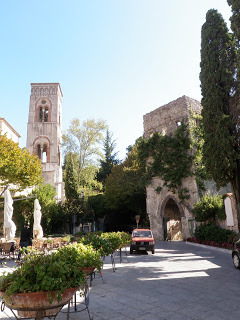
We parked near the new concert hall designed by Oscar Niemeyer. Its jarring design looked to me like a gigantic eye out of character to the surroundings.. We turned away from its hard gaze to enter the mellow and harmonious town center, the Piazza Vescavado. The sunlight fell on the piazza, the 11th Century Duomo, the Moorish-style Villa Rufulo and two bars with tables defiantly set outside despite the temperature. We joined determined sippers nursing their cappuccini while keeping hunched up against the cold.
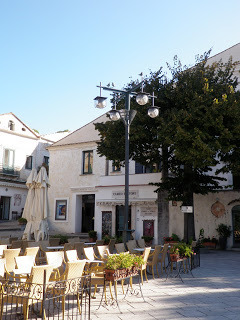
The economy of Ravello is based on painted ceramics, limoncello, a famous summer festival where guests can contemplate the infinite blue coastline, sea and sky while enjoying the music, and beautiful luxury hotels to accommodate sybarites. Perfection.
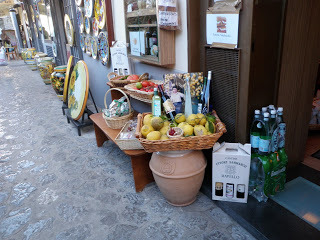
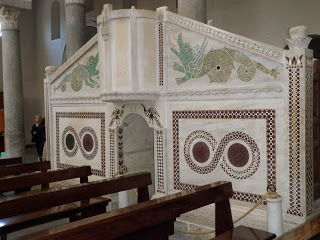 Our goal on this short visit was simply to brighten our memories before we headed off elsewhere for new sights. As usual we started with a visit to the Duomo, one of my favorites because of its beautiful medieval decor. The cathedral, founded in 1086, is graced with mosaics of fantastic animals and the sinuously curling designs typical of the period, often called Cosmati work, after two brothers who popularized the style in medieval Rome. The elaborate layouts consist of strips of small triangles, squares and other shapes made of red porphyry, green serpentine, gold glass and black marble in concentric, intertwined or other geometric motifs set into white marble. The shapes often curve around large disks of colored stone as they move across the surfaces, snake-like.
Our goal on this short visit was simply to brighten our memories before we headed off elsewhere for new sights. As usual we started with a visit to the Duomo, one of my favorites because of its beautiful medieval decor. The cathedral, founded in 1086, is graced with mosaics of fantastic animals and the sinuously curling designs typical of the period, often called Cosmati work, after two brothers who popularized the style in medieval Rome. The elaborate layouts consist of strips of small triangles, squares and other shapes made of red porphyry, green serpentine, gold glass and black marble in concentric, intertwined or other geometric motifs set into white marble. The shapes often curve around large disks of colored stone as they move across the surfaces, snake-like.
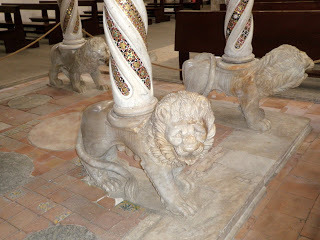 On an earthy note, the large free-standing pulpit is supported by six spiral pillars in turn supported by six anatomically correct lions, three females and three males. The females have their tails off to one side, seemingly waiting for their partners. The priest must have had difficulties keeping the parishioners' attention with this visual competition. The religious iconography escaped us but the quality of the sculpture was superb.
On an earthy note, the large free-standing pulpit is supported by six spiral pillars in turn supported by six anatomically correct lions, three females and three males. The females have their tails off to one side, seemingly waiting for their partners. The priest must have had difficulties keeping the parishioners' attention with this visual competition. The religious iconography escaped us but the quality of the sculpture was superb.Other religious artifacts attracted our ever-curious eyes: vials of St. Pantaleone's holy blood which is said to liquefy on July 27th, part of St. Thomas' finger bone and Santa Barbara's skull held in a gorgeous reliquary done up in gold and silver. These leftover pieces are a grisly pleasure to behold although the treasures in Ravello cannot hold a candle to those in Baroque Rome where there must be enough to make several new saints if they were all put together.
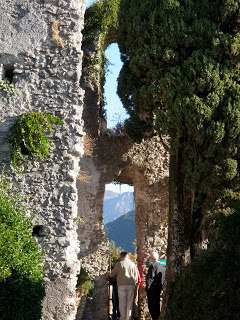 Our minds full, we turned to the idyllic Villa Rufolo and Villa Cimbrone, the best places to contemplate the beauties of the Amalfi Coast where delight is present in every direction: gardens with sub-tropical vegetation, statuary, fountains, towering cypresses, the sea far below and the sky far above. No wonder so many artists came to the town to paint, write, or think although the reality is that the town was founded in the 5th century as a shelter, inaccessible to the barbarians on the coast.
Our minds full, we turned to the idyllic Villa Rufolo and Villa Cimbrone, the best places to contemplate the beauties of the Amalfi Coast where delight is present in every direction: gardens with sub-tropical vegetation, statuary, fountains, towering cypresses, the sea far below and the sky far above. No wonder so many artists came to the town to paint, write, or think although the reality is that the town was founded in the 5th century as a shelter, inaccessible to the barbarians on the coast.It is hardly possible to leave without buying a brightly painted plate or bowl. As usual I succumbed to a bowl with brightly painted lemons and a bottle of limoncello. Visions of a long summer lunch played in my mind, an aperitivo of the liqueur served ice-cold, followed by a Caprese with mozzarella di bufala, and then pasta primavera showing off in the new bowl.
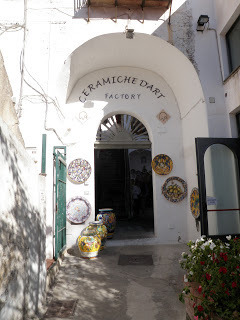
Ah – the delights of Italy.
Published on January 23, 2012 15:27
January 16, 2012
Via Etrusca
I have a friend who lives in a small town an hour north of Rome. Her home is on Via Etrusca, a perfect name for visualizing the area's continuing Etruscan influence even though the Romans had finished them off by the Third Century BC. The town, set high on a cliff, has no tourist attractions but is kept alive by commuters and city dwellers who have restored their former family home for weekend use. The ancient row houses are thought to be between four to six centuries old, the year the buildings were actually erected long forgotten. To ensure that the structures stay in place for at least another half-millennium, the buildings are supported by arches vaulting over the narrow stone-paved streets.
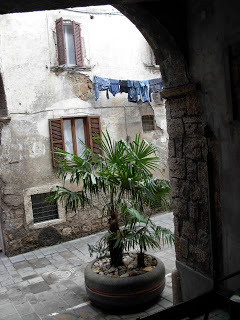 Late in the evening when there are only glowing embers in the fireplace flickering on the ancient oak beams and the art work resting in niches, and the red wine bottle is emptied to the dregs, the silence is as complete as it must have been when my friend's home was new.
Late in the evening when there are only glowing embers in the fireplace flickering on the ancient oak beams and the art work resting in niches, and the red wine bottle is emptied to the dregs, the silence is as complete as it must have been when my friend's home was new.
A few lights shine over empty streets, through the arches and the closed shutters of my bedroom. I sleep, dreamless. But early in the morning I awake to the sound of Vespa engines. It's time for workers to get going and for me to open the shutters and let in the day. Instead I drowsily think about all the people who might have lived in this home in times past.
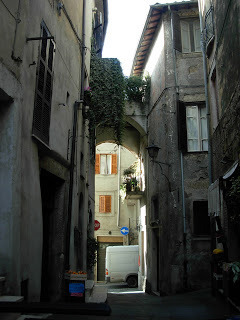
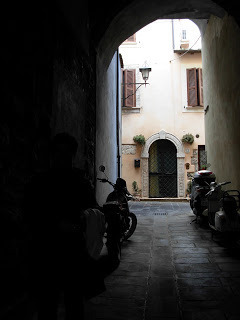
Later, my friend and I walk a few blocks to the small shopping street. If we get going too early the bar owner is still firing up his espresso maker for those dashing to the train station in the valley far below the centro storico perched on its rock. The giornalaio is putting up his rack with the day's papers blaring out the latest political scandal, while fruit and flower vendors are pulling up their metal shutters and moving their wares outside in the clear light. Life begins anew for commuters hurrying to their jobs in Rome and for us to plan another day of sightseeing in nearby towns like tiny one-street Sovana, Bomarzo with its strange monster sculptures, or Viterbo's papal palace.
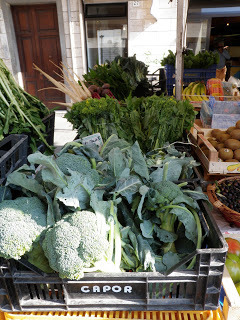 Like all small towns in Italy life goes on for the remaining residents. I can peek through open windows and doors to see remodeled kitchens, new televisions and other indications of renewal. By mid-morning a delectable smell of pasta sauce comes from kitchen windows and from unpretentious shops where fresh lasagna is prepared for those who don't have time or inclination to cook. Shoppers are eyeing flowers, vegetables and fruit carefully arranged in the minuscule shops sandwiched between offices of the various political parties or those of the pompe funebri, undertakers. Artisans are busy making picture frames, mending shoes or painting ceramics. Butcher shops and tintorias, dry cleaners, bustle with business. Women buy knitting supplies in the merceria where thread, hosiery and shoulder pads for the home seamstress are displayed behind the counter.
Like all small towns in Italy life goes on for the remaining residents. I can peek through open windows and doors to see remodeled kitchens, new televisions and other indications of renewal. By mid-morning a delectable smell of pasta sauce comes from kitchen windows and from unpretentious shops where fresh lasagna is prepared for those who don't have time or inclination to cook. Shoppers are eyeing flowers, vegetables and fruit carefully arranged in the minuscule shops sandwiched between offices of the various political parties or those of the pompe funebri, undertakers. Artisans are busy making picture frames, mending shoes or painting ceramics. Butcher shops and tintorias, dry cleaners, bustle with business. Women buy knitting supplies in the merceria where thread, hosiery and shoulder pads for the home seamstress are displayed behind the counter.
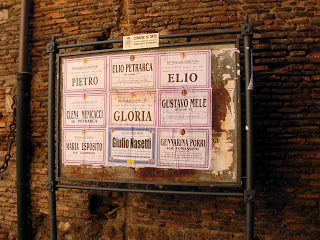 But despite the liveliness, the unstoppable passage of time is always evident. Large death notices are pasted on walls between fading and tattered posters for the small circuses that had come to town in past years. When summer is over old men, wearing heavy sweaters under their jackets along with scarves and caps, will follow the sun as it passes around the piazza. They are living sundials as they move like dozing cats, smoking and discussing how the hometown soccer team is faring.
But despite the liveliness, the unstoppable passage of time is always evident. Large death notices are pasted on walls between fading and tattered posters for the small circuses that had come to town in past years. When summer is over old men, wearing heavy sweaters under their jackets along with scarves and caps, will follow the sun as it passes around the piazza. They are living sundials as they move like dozing cats, smoking and discussing how the hometown soccer team is faring.
But I still have many places to go before I, too, want to doze in the sun.

 Late in the evening when there are only glowing embers in the fireplace flickering on the ancient oak beams and the art work resting in niches, and the red wine bottle is emptied to the dregs, the silence is as complete as it must have been when my friend's home was new.
Late in the evening when there are only glowing embers in the fireplace flickering on the ancient oak beams and the art work resting in niches, and the red wine bottle is emptied to the dregs, the silence is as complete as it must have been when my friend's home was new.A few lights shine over empty streets, through the arches and the closed shutters of my bedroom. I sleep, dreamless. But early in the morning I awake to the sound of Vespa engines. It's time for workers to get going and for me to open the shutters and let in the day. Instead I drowsily think about all the people who might have lived in this home in times past.


Later, my friend and I walk a few blocks to the small shopping street. If we get going too early the bar owner is still firing up his espresso maker for those dashing to the train station in the valley far below the centro storico perched on its rock. The giornalaio is putting up his rack with the day's papers blaring out the latest political scandal, while fruit and flower vendors are pulling up their metal shutters and moving their wares outside in the clear light. Life begins anew for commuters hurrying to their jobs in Rome and for us to plan another day of sightseeing in nearby towns like tiny one-street Sovana, Bomarzo with its strange monster sculptures, or Viterbo's papal palace.
 Like all small towns in Italy life goes on for the remaining residents. I can peek through open windows and doors to see remodeled kitchens, new televisions and other indications of renewal. By mid-morning a delectable smell of pasta sauce comes from kitchen windows and from unpretentious shops where fresh lasagna is prepared for those who don't have time or inclination to cook. Shoppers are eyeing flowers, vegetables and fruit carefully arranged in the minuscule shops sandwiched between offices of the various political parties or those of the pompe funebri, undertakers. Artisans are busy making picture frames, mending shoes or painting ceramics. Butcher shops and tintorias, dry cleaners, bustle with business. Women buy knitting supplies in the merceria where thread, hosiery and shoulder pads for the home seamstress are displayed behind the counter.
Like all small towns in Italy life goes on for the remaining residents. I can peek through open windows and doors to see remodeled kitchens, new televisions and other indications of renewal. By mid-morning a delectable smell of pasta sauce comes from kitchen windows and from unpretentious shops where fresh lasagna is prepared for those who don't have time or inclination to cook. Shoppers are eyeing flowers, vegetables and fruit carefully arranged in the minuscule shops sandwiched between offices of the various political parties or those of the pompe funebri, undertakers. Artisans are busy making picture frames, mending shoes or painting ceramics. Butcher shops and tintorias, dry cleaners, bustle with business. Women buy knitting supplies in the merceria where thread, hosiery and shoulder pads for the home seamstress are displayed behind the counter. But despite the liveliness, the unstoppable passage of time is always evident. Large death notices are pasted on walls between fading and tattered posters for the small circuses that had come to town in past years. When summer is over old men, wearing heavy sweaters under their jackets along with scarves and caps, will follow the sun as it passes around the piazza. They are living sundials as they move like dozing cats, smoking and discussing how the hometown soccer team is faring.
But despite the liveliness, the unstoppable passage of time is always evident. Large death notices are pasted on walls between fading and tattered posters for the small circuses that had come to town in past years. When summer is over old men, wearing heavy sweaters under their jackets along with scarves and caps, will follow the sun as it passes around the piazza. They are living sundials as they move like dozing cats, smoking and discussing how the hometown soccer team is faring.But I still have many places to go before I, too, want to doze in the sun.
Published on January 16, 2012 07:14
January 9, 2012
A Visit to James Norman Hall's Home in Tahiti
One of the most pleasant stops on the Island of Tahiti is the home of the author, James Norman Hall. Not far from Papeete the modest wood structure is now a small museum celebrating Hall's life and his books and movies.
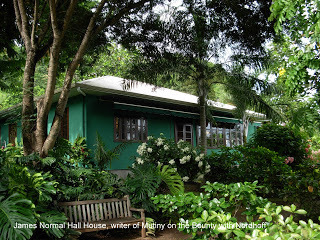 His most famous work is the Bounty Trilogy, comprising the story of the mutiny on the British ship, HMS Bounty, and the aftermath.
His most famous work is the Bounty Trilogy, comprising the story of the mutiny on the British ship, HMS Bounty, and the aftermath.
The first section, Mutiny on the Bounty, is the story of the ship's voyage from the West Indies to Tahiti to collect breadfruit seedlings to be planted for slave food and the infamous mutiny led by Fletcher Christian who didn't want to leave the sybaritic island. He and a few other sailors commandeered the ship and set the captain and the remainder of the sailors adrift.
The second, Men Against the Sea, tells the story of one of the most amazing nautical feats ever undertaken: Captain Bligh's journey in an open boat – 23-feet long filled with 18 loyal sailors – on a journey of 3600 miles to safety in the Dutch East Indies.
The trilogy is completed with Pitcairn's Island, recounting the violent life of the mutineers after they settled on Pitcairn Island, a speck in the middle of the Pacific. The mutiny and the story of the mutineers' lives have been retold many times in film: first an Australian effort with Errol Flynn, followed by the American versions starring Clark Gable, Marlon Brando, and most recently with Mel Gibson cast as Fletcher Christian, the lead mutineer. (I met one of Christian's descendants on Pitcairn.)
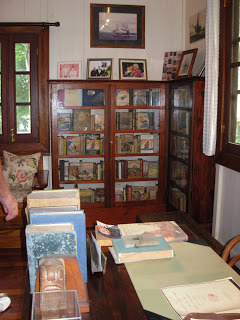
Of Hall's 12 books Passage to Marseille, Hurricane and Botany Bay were also made into films.
The modest home's living-dining room has a large bookcase to display the many editions of the writer's work, each with its colorful book jacket depicting titles in dozens of languages. Movie posters from his films decorate the walls. Another room has mementos of Hall's service in World War I when he joined the famous Lafayette Escadrille, the American squadron named in honor of France's champion of American independence. Hall was shot down and spent time as a German prisoner of war. Later he was awarded almost every honor France could bestow including the Legion of Honor and the Croix d'Guerre.
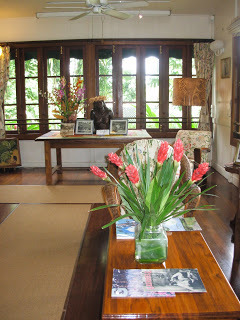
The home is open to the surrounding gardens filled with torch ginger and other tropical colors. When my husband and I visited we met Hall's delightful daughter. The elegant old lady, wearing a pink dress, a flower over her right ear and a string of luscious black pearls around her neck, sat by a window overlooking the gardens. She regaled us with stories of her Tahitian childhood and read from the book her father wrote for her and her brother when they were children. She also talked about their fear of invasion during World War II, not without reason as nearby Bora Bora was used by the U.S. as a military supply base. Old naval defense guns still remain on the island resting on the jungled slopes above luxury hotels.
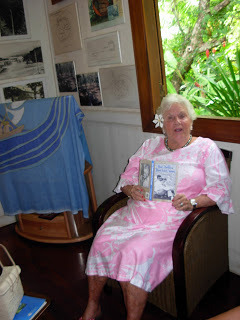
Whatever the fears of the past, the home was a haven, an oasis where it was easy for me to imagine the author using the peaceful surroundings to concentrate on telling us timeless stories.


 His most famous work is the Bounty Trilogy, comprising the story of the mutiny on the British ship, HMS Bounty, and the aftermath.
His most famous work is the Bounty Trilogy, comprising the story of the mutiny on the British ship, HMS Bounty, and the aftermath. The first section, Mutiny on the Bounty, is the story of the ship's voyage from the West Indies to Tahiti to collect breadfruit seedlings to be planted for slave food and the infamous mutiny led by Fletcher Christian who didn't want to leave the sybaritic island. He and a few other sailors commandeered the ship and set the captain and the remainder of the sailors adrift.
The second, Men Against the Sea, tells the story of one of the most amazing nautical feats ever undertaken: Captain Bligh's journey in an open boat – 23-feet long filled with 18 loyal sailors – on a journey of 3600 miles to safety in the Dutch East Indies.
The trilogy is completed with Pitcairn's Island, recounting the violent life of the mutineers after they settled on Pitcairn Island, a speck in the middle of the Pacific. The mutiny and the story of the mutineers' lives have been retold many times in film: first an Australian effort with Errol Flynn, followed by the American versions starring Clark Gable, Marlon Brando, and most recently with Mel Gibson cast as Fletcher Christian, the lead mutineer. (I met one of Christian's descendants on Pitcairn.)

Of Hall's 12 books Passage to Marseille, Hurricane and Botany Bay were also made into films.
The modest home's living-dining room has a large bookcase to display the many editions of the writer's work, each with its colorful book jacket depicting titles in dozens of languages. Movie posters from his films decorate the walls. Another room has mementos of Hall's service in World War I when he joined the famous Lafayette Escadrille, the American squadron named in honor of France's champion of American independence. Hall was shot down and spent time as a German prisoner of war. Later he was awarded almost every honor France could bestow including the Legion of Honor and the Croix d'Guerre.

The home is open to the surrounding gardens filled with torch ginger and other tropical colors. When my husband and I visited we met Hall's delightful daughter. The elegant old lady, wearing a pink dress, a flower over her right ear and a string of luscious black pearls around her neck, sat by a window overlooking the gardens. She regaled us with stories of her Tahitian childhood and read from the book her father wrote for her and her brother when they were children. She also talked about their fear of invasion during World War II, not without reason as nearby Bora Bora was used by the U.S. as a military supply base. Old naval defense guns still remain on the island resting on the jungled slopes above luxury hotels.

Whatever the fears of the past, the home was a haven, an oasis where it was easy for me to imagine the author using the peaceful surroundings to concentrate on telling us timeless stories.

Published on January 09, 2012 10:42



